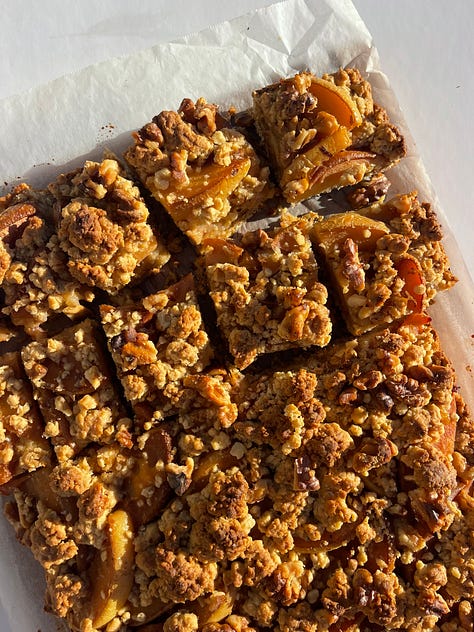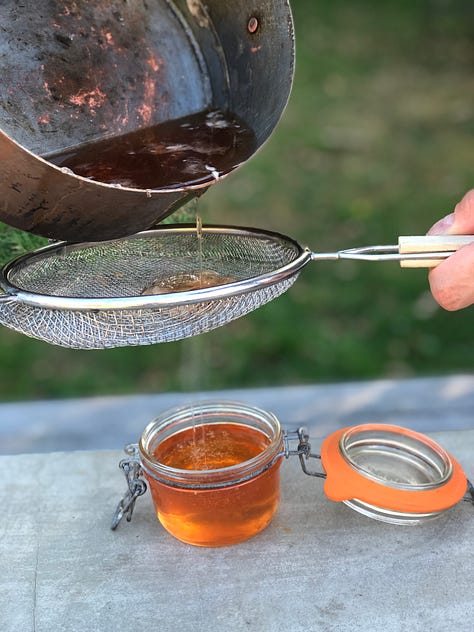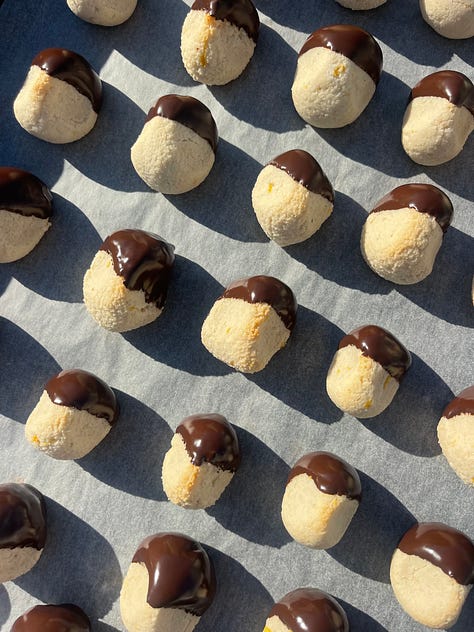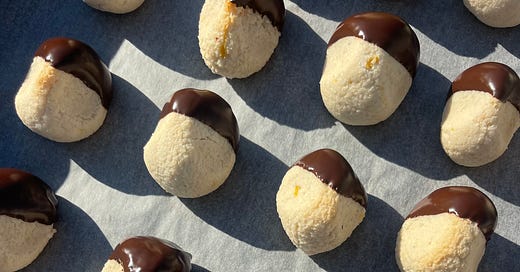Quinces this week - an oaty shortcake with poached quince and walnut, and quince jelly. And, as an extra treat for Mother's Day - lemon and chocolate baci.



I often rabbit on about my love for quinces. They’re part of what makes autumn delightful; that first bowl of them on the kitchen table, vaguely reminiscent of 15th century Flemish masters, perfuming the place with their sweet, pineapple-y fragrance.
I get quite short with those who spurn them. They’re more available than you think; the season is short but plentiful, and they’re often cheaper than apples or pears. I wouldn’t suggest eating them raw, except as punishment for naughty children or someone you don’t like; but the best thing you can do to a quince is a long, slow cook into submission.
Simply halved, in a baking dish, with a bit of water in the bottom of the pan, some brown sugar, a bit of vanilla, and give them a long, slow, gentle bake - and then served up with vanilla ice cream - bloody delicious.
They’re native to Western Asia, so Iran, Armenia, Afghanistan and so on. The Akkadians and the Mesopotamians cultivated them for hanging gardens, and the Greeks were so convinced of the potent qualities of a quince that it became a symbol of Aphrodite. Newlyweds were advised to have one in the bed with them on their wedding night. God only knows what they did with it.
Quince trees made it to London in 1275, when Edward I had some planted around the Tower of London. A Roman recipe for quince preserve remained especially popular in Spain and Portugal, and was the ancestor to today’s quince paste. Indeed, the word ‘marmalade’, originally meant quince jam and derives from marmelo, meaning quince in Portuguese.
The shortcake can be made with any kind of fruit, really, but is so delicious with quince; when cooked it is rather like soft, fragrant, pineapple-y apple.
I will use the base for just about any kind of fruit that is in season. Apple, pear, berries, stewed fruit…and then there’s the chocolate / caramel / etc path, where things get a little dangerous. In what was my first foray into food television, I rather nervously made a chocolate version of it on Good Morning, touting it as something I’d grown up with, so it’s a recipe I get a bit sentimental about.
Family and friends look at it with equal measures of affection and trepidation, given that once you start with one piece, you can’t really stop. The key is to not to polish off a tray of it in a single sitting, although I can’t guarantee that that won’t happen. Let’s tell ourselves that the oats make it healthy.
I go through phases with quince preserves. Some years I get all ambitious and embark on vast production lines of jelly, jam and paste, which will keep me sorted for months afterwards, but the problem is, quince paste is a bit of a character test. If you have the patience then I wish you well, but be extremely wary of it spitting at you as it cooks down. Ever had a quince paste burn? The stuff is like napalm. I tend to make it every two years so that I have time to recover.
Quince jelly, on the other hand, is a much more peaceful process. The natural pectin in the pips helps to set the jelly, so make sure that you include all of them in the pan. What you end up with is a delicately sweet, fragrant elixir which makes a very welcome addition to just about anything to do with red meat (especially lamb or venison), or cheese (especially the harder varieties such as a good cheddar or a gouda), be it on a platter or in a toastie, or simply smeared on a bit of bread with some soft curd. The jelly will keep indefinitely as long as you sterilise the jars well, and presented as such they also make very cute little gifts
And a gorgeous little treat just in time for Mother’s Day - baci. They’re easy to make and extremely cute. And extremely moreish.
Have a lovely rest of the weekend, and happy cooking, as always.
S xx
LEMON AND CHOCOLATE BACI
Baci di dama, or ladies kisses, originate from Piedmont, in the north-west of Italy. They’re gorgeous little almondy lemony chocolatey treats - not too sweet, not too heavy. Terribly satisfying with coffee. I love them.
For mother’s day, I think they’re perfect.
Traditionally ground hazelnuts are used, and if you do have access to some, by all means use that instead of ground almonds.





